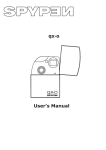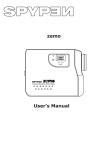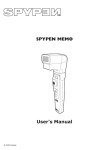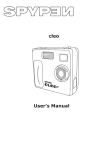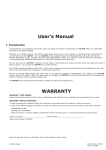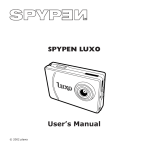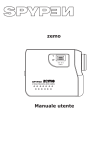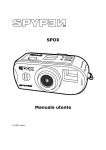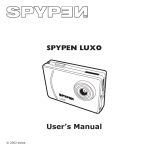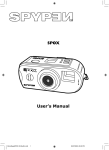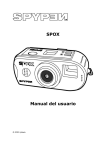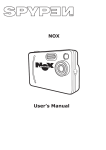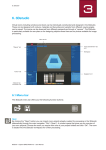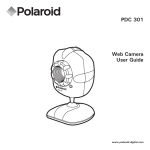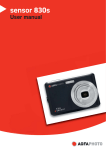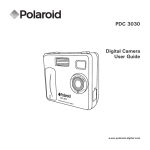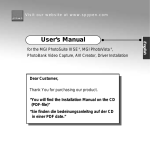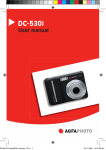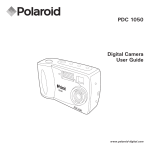Download OBOE ML UM UK.indd
Transcript
User’s Manual Product Overview 1. 2. 3. 4. 5. 6. Flash Shutter button Up / Zoom In button Down / Zoom Out button Menu button Viewfinder Top view 1. 2. 3. 4. Reset switch Camera stand clip Power button Mode selector Side view 1. 2. 3. 4. Flash Pop-up button SD card slot USB port TV-out terminal Side view 1. Lens 2. Self-timer/Charge LED 3. Microphone Front view 2 Table of Contents 1 Getting Started ....................................................................................................................... 4 • Camera Package Contents ..................................................................................................... 4 • Using the Camera Stand........................................................................................................ 4 • Charging the Battery ............................................................................................................ 4 • Powering the Camera On and Off ............................................................................................ 5 • Checking the Battery Level .................................................................................................... 5 • Setting Auto Power Off .......................................................................................................... 5 • Reset Function ..................................................................................................................... 5 • Checking Camera Status ....................................................................................................... 6 2 Camera Setting....................................................................................................................... 6 • Camera Modes ..................................................................................................................... 6 • Setting the Beep Sound On and Off......................................................................................... 6 • Restoring the Factory Settings................................................................................................ 7 • Setting Display Language ...................................................................................................... 7 3 Taking Pictures ....................................................................................................................... 7 • Taking a Picture.................................................................................................................... 7 • Setting Exposure Compensation ............................................................................................. 8 • Setting the White Balance ..................................................................................................... 8 • Setting Image Resolution ...................................................................................................... 9 • Using the Flash .................................................................................................................... 9 • Setting Self-timer ............................................................................................................... 10 • Using the 4X Digital Zoom Function ...................................................................................... 10 • Setting Frequency .............................................................................................................. 10 4 Recording Video Clips ........................................................................................................... 11 • Recording Video Clips.......................................................................................................... 11 5 Playback Pictures and Video Clips ............................................................................................ 11 • Reviewing Pictures on the Screen ......................................................................................... 11 • Playback Video clips on the Screen ....................................................................................... 11 • Protect/Unprotect the Pictures or Video Clips Against Deletion .................................................. 11 • Deleting One Picture or Video Clip......................................................................................... 12 • Deleting All Pictures and Video Clips...................................................................................... 12 • Setting TV-out ................................................................................................................... 13 6 Using SD (Secure Digital) Card ............................................................................................... 14 • Using the SD Card .............................................................................................................. 14 • To Format a Memory Card.................................................................................................... 15 • About DPOF ....................................................................................................................... 15 7 Installing Software onto a Computer ........................................................................................ 16 • Installing the Software ........................................................................................................ 16 • Software Included with Your Camera ..................................................................................... 16 • Computer System Requirements........................................................................................... 17 8 Transferring Pictures, Video Clips to Your Computer ................................................................... 18 • Before You Transfer Pictures and Video Clips .......................................................................... 18 • Mass Storage/PC CAM ......................................................................................................... 18 • Connecting to Your Computer............................................................................................... 18 • Transferring and Viewing the Pictures and Video Clips on PC..................................................... 19 • Transferring and Viewing the Pictures and Video Clips on Mac ................................................... 19 9 Using the Camera as a Web Cam (PC only) ............................................................................... 19 • Setting up NetMeeting™ ...................................................................................................... 19 • Start NetMeeting™ ............................................................................................................. 19 10 Troubleshooting Problems....................................................................................................... 20 11 Getting Help ......................................................................................................................... 21 • Online Services .................................................................................................................. 21 • Customer Support .............................................................................................................. 21 • ArcSoft Software Help ......................................................................................................... 21 12 Appendix ............................................................................................................................. 22 • Technical Specifications ....................................................................................................... 22 • Tips, Your Safety & Maintenance........................................................................................... 22 • Uninstalling the Camera Driver (PC only) ............................................................................... 22 • Regulatory Information ....................................................................................................... 23 3 1 Getting Started The Spypen oboe camera provides you easy-to-use features. It has now easier and more enjoyable. Here are a few examples of what you can do with your camera. Enjoy point & shoot operation. Store pictures and video clips to the internal memory. Playback of pictures and video clips on the screen or a computer. Send the pictures and video clips over the Internet to family and friends. • Camera Package Contents Spypen oboe USB Cable The CD-ROM includes Digital Camera Driver (PC) Arcsoft® Software Suite (PC & Mac) Microsoft® NetMeeting™ Adobe® Acrobat® Reader (PC & Mac) User’s manual in PDF format. Warranty Card Camera stand AV Cable • Using the Camera Stand • Charging the Battery A rechargeable battery (non-replaceable) is integrated into camera. Please fully charge the battery for approximately 10 hours before you use the camera for the first time, and about 3 hours for subsequent recharging. The integrated battery should last for the life of the camera, but as is the case with all rechargeable batteries the actual charge held may decline with use. You can only charge the battery by connecting it to the computer via a USB cable. Your computer must be powered on for your camera to charge. Please follow the steps below: 1. Plug the USB A plug into a USB port on your computer. 2. Plug the other end of the USB cable into the USB port on your camera. 3. The battery begins charging and the Charging LED lights up in green. The LED will blink when the battery is fully charged. NOTE: Power off the camera before charging the battery. Otherwise, the Charge LED will light up in orange, indicating that the camera is not in the charge mode. 4 • Powering the Camera On and Off Press and hold the Power button to power on the camera. The screen will be turned on in two seconds. You can see the screen through the viewfinder. Press and hold the Power button again will power the camera off. Power button • Checking the Battery Power Level Check the battery power level before taking pictures. 1. Power on the camera. 2. Check the battery power level that appears on the camera screen. Battery has adequate power. Only half of the battery power is left. Battery power is low. Please charge the battery. • Setting Auto Power Off This camera is designed to automatically power off to save battery life in 1 min. /3 min. of inactivity. Press the Power button if you want to power on the camera again. You can change the power saving setting by the following steps: Power on the camera. Press Shutter button Press Press Shutter button Press Shutter button Select “Off” to disable the Auto Power off function. • Reset Function In the rare situation that the camera locks up (usually in a very low power situation), we have incorporated a “camera reset switch” on the side of the camera that allows the camera processor to be reset without losing any images. To use the reset switch, simply depress the reset switch gently using a paper clip or ball point pen. The camera will reboot and return to the mode prior to the lock-up. It is important to note that the camera needs to be recharged immediately in order to avoid locking up again. Reset switch 5 • Checking Camera Status Power on the camera, view the camera screen to check which camera settings are active. If the feature icon is not displayed, it means that particular feature is not activated. Video Mode Still Image Mode Playback Mode 00:12 Still Image Resolution Camera Status Other Features Self-timer On Still Image Mode (Fine) 2048 x 1536 Flash Off Video Mode (Normal) 1600 x 1200 Flash On Auto Flash Focus Mark Pictures remaining Zoom status bar (Economic) 800 x 600 Locked file Recording SD Card inserted Battery Power Level Full 00:12 Current file/Number of files Low Half The length of video clip remaining 2 Camera Setting • Camera Modes The camera has three working modes: Still Image mode and Playback mode . Use the Mode , Video mode selector to select the mode you prefer. Mode selector • Setting the Beep Sound On and Off When the Beep sound is turned on, the camera will beep when you press the buttons. You can turn the Beep sound on and off in the Still Image and Playback modes. We use Still Image mode as an example. Power on the camera. Press Shutter button Press Press Shutter button Press Shutter button 6 • Restoring the Factory Settings You can easily change all the settings that you have made back to the camera default settings by the following steps. You can restore the Factory default setting in the Still Image and Playback modes. We use Still Image mode as an example. Power on the camera. Press Shutter button Press Press Shutter button Press Shutter button • Setting Display Language Under this setting, you can select the language you prefer for the screen. You can change the Language setting in the Still Image and Playback modes. We use Still Image mode as an example. Power on the camera. Press Shutter button Press Press Shutter button Press Shutter button 3 Taking Pictures • Taking a Picture 1. 2. 3. Power on the camera. Set the Mode Selector to Still Image mode . Use the screen to frame your subject. Hold the camera steady and press the Shutter button to take a picture. A beep will sound when the picture has been taken. The counter on the screen will decrease by one. 7 Shutter button • Setting Exposure Compensation You can adjust the exposure compensation value (EV) within the range of -1.5EV to +1.5EV in order to compensate for current lighting conditions. This setting can be used to obtain better result when shooting with backlighting, indirect indoor lighting, a dark background, and so on. Power on the camera. Set the Mode selector to Still Image mode. Press Shutter button Press Press Shutter button Press Shutter button NOTE: • A higher EV value is best for light-coloured subjects and backlight subjects. A lower EV value is best for dark-coloured subjects and for shooting outdoors on a clear day. • When shooting under very dark or very bright conditions, you may not be able to obtain satisfactory results even after performing exposure compensation. • Exposure compensation returns to its standard default setting (AUTO) after you power off and power on the camera again. • Setting the White Balance Selecting the right type of white balance can help to make the colour of a subject appear more natural under the type of lighting that is available. Power on the camera. Set the Mode selector to Still Image mode. Press Shutter button Press Press Shutter button Press Shutter button 8 • Setting Image Resolution Picture resolution refers to the number of pixels in a digital picture. The higher the resolution, the more pixels in your picture and the more memory space the picture uses. A higher resolution takes up more memory but produces a higher quality digital picture when printed. Power on the camera. Set the Mode selector to Still Image mode. Press Shutter button Press Press Shutter button Press Shutter button Here is the approximate number of pictures you can expect the camera to hold at each setting based on the 16MB internal memory. F: 2048 x 1536; approximately 17 pictures N: 1600 x 1200; approximately 28 pictures E: 800 x 600; approximately 105 pictures • Using the Flash Use the flash when you take pictures at night, indoors, or outdoors in heavy shadows. The flash icon that is displayed on the screen is the active option. You can change the flash setting by the following steps: Power on the camera. Set the Mode selector to Still Image mode. Press Shutter button Press Press Shutter button Press Shutter button Flash Mode On - The flash fires for every picture. Use this setting in high-contrast situations to provide fill-light or use it indoors in low light. Auto Flash Mode - The flash fires automatically as needed. Use this setting to take most pictures. NOTE: • Flash is not available in Video mode. • Never touch or block the flash with your fingers. Doing so can soil these components and interfere with the correct flash operation. • Effective flash light range: Approx. 3.3~5.0 feet (Approx. 1.0~1.5m) 9 • Setting Self-timer Your camera is designed with a self-timer function, which allows you to take pictures with a 10-second builtin timer. Place the camera on a flat surface or use a tripod when using the Self-timer function. 1. Power on the camera. Set the Mode Selector to Still Image mode 2. Follow the steps below to activate the Self-timer function: . Press Shutter button Press Press Shutter button Press Shutter button 3. Frame your subject using the screen. 4. Press the shutter button to take a picture. 5. The self-timer LED blinks in red and the camera beeps to indicate that the countdown is being performed. The camera beeps for 6 seconds and then quicker for 6 seconds. The self-timer turns off automatically when the picture is taken. • Using the 4X Digital Zoom Function The digital zoom feature is available in Still Image and Video modes. This feature enlarges the central area of an image and photograph only the enlarged portion of the image. Images can be enlarged up to 4 times before the image is taken. A bar appears on the screen, indicating the zoom status. The zoom setting will remain after taking pictures. Please zoom out to take standard pictures. • Setting Frequency In order to take a better indoor picture, the camera needs to be set to suit the correct lighting frequency. Set the frequency to 60Hz for US, 50Hz for Europe. You can change the Frequency setting in the Still Image and Playback modes. We use Still Image mode as an example. Power on the camera. Press Shutter button Press Press Shutter button Press Shutter button 10 4 Recording Video Clips • Recording Video Clips Use the Video mode to record video clips. You can record video clips with audio feature, and the resolution is set to 320x240 pixels automatically. The remaining recording time on the screen will decrease while recording video clips. . 1. Power on the camera. Set the Mode selector to Video mode 2. Frame your subject using the screen. 3. Press the Shutter button to start recording. 4. Press the Shutter button again to stop recording, or recording stops when the current memory is full. 5 Playback Pictures and Video Clips • Reviewing Pictures on the Screen 1. Power on the camera. Set the Mode Selector to Playback mode 2. Use the Up/Down buttons to view the pictures taken. . • Playback Video clips on the Screen . 1. Power on the camera. Set the Mode Selector to Playback mode 2. Use the Up/Down buttons to select a video clip which is indicated by a video icon 3. Press the Shutter button to play the video clip. Press it again to stop playing. . • Protect/Unprotect the Pictures or Video Clips Against Deletion Power on the camera. Set the Mode selector to Playback mode . Press the Up/Down buttons to select a picture or a video clip you want to protect. Press Shutter button Press Press Shutter button Press Shutter button Select “Lock” to protect and “Unlock” to unprotect. The picture or video clip under Playback mode. 11 icon appears when you review the protected • Deleting One Picture or Video Clip . Use Up/Down button to select a picture Power on the camera. Set the Mode Selector to Playback mode appears on the screen when a video or video clip you want to delete. Please note that the video icon clip is selected. Press Shutter button Press Press Shutter button Press Shutter button • Deleting All Pictures and Video Clips You can delete all unprotected pictures and video clips in the current memory as follows: . Power on the camera. Set the Mode Selector to Playback mode Press Shutter button Press Press Shutter button Press Shutter button 12 • Setting TV-out Setting the Video Output System The video output signal (NTSC or PAL) can be switched to accommodate different signal systems. For example: NTSC for USA, Canada, Taiwan, Japan, etc. and PAL for Europe, Asia (excluding Taiwan), and so on. You can change the video output system setting in the Still Image and Playback modes. We use Still Image mode as an example. Power on the camera. Press Shutter button Press Press Shutter button Press Shutter button Connecting to a TV When the camera is connected to a TV, the TV screen now performs as the camera screen. 1. Connect the camera to a TV via the AV cable (supplied) as illustrated. 2. Set the TV to “video” mode. 3. When the Mode Selector is set to Still Image and Video modes, you can preview the subjects you want to record on the TV screen. AV cable , you can review 4. When the camera is set to Playback mode all the pictures and video clips stored in the camera on the TV. NOTE: Please do not connect the USB cable to the camera while it is connected to the TV, vice versa. 13 6 Using SD (Secure Digital) Card • Using the SD Card IMPORTANT! Files contained in the card may conflict with the Spypen oboe camera, valuable data in your existing SD card may be distorted or lost when the card is inserted in the Spypen oboe camera. We strongly recommend the user to use a NEW SD card for the Spypen oboe camera. We are not liable for losing or corrupting any valuable data or files in your SD card due to your improper operation. Your camera comes with a built-in 16MB flash memory for storing pictures and video clips as you record them. You can expand the memory space by using a commercially available SD card (up to 256MB). The camera senses whether a memory card is inserted, and automatically saves pictures and video clips accordingly. Note that you can not save pictures and video clips to the built-in flash memory while a memory card is inserted into the camera. Memory Card Precautions 1. Only use a SD memory card with this camera. Proper operation is not guaranteed when any other type of card is used. 2. Electrostatic charge, electrical noise, and other phenomena can cause data corruption or even loss. Always make sure that you always back up important data on other media (MO disc, computer hard drive, and so on). 3. If a memory card starts to behave abnormally, you can restore normal operation by formatting it. However, we recommend that you always take along more than one memory card whenever using the camera far away from the home or office. 4. We recommend that you format a memory card before using it for the first time after purchasing it, or whenever the card you are using seems to be the cause of abnormal pictures. Remember to format a memory card if it was used in another digital camera or other devices. IMPORTANT! • Make sure you power off the camera before inserting or removing a memory card. • Be sure to orient the card correctly when inserting it. Never try to force a memory card into the slot when you feel resistance. • SD memory cards have a write protection switch, which you can use to protect against accidental deletion of picture and video clip files. Note that you must remove the write protection (if the memory card is under write protection) whenever you want to record pictures and video clips to it, format it, or erase pictures and video clips. Inserting the SD Card Power off the camera. Open the rubber cover, insert the SD card ensuring the card is inserted correctly as illustrated. IMPORTANT! • Never insert any other objects except a SD memory card into the camera’s card slot. Doing so creates the risk of damaging the camera and the memory card. • Should water or any foreign objects ever get into the card slot, immediately power off the camera, and contact your dealer or nearest service provider. 14 SD�Card� Removing the SD Card To remove the SD card, power off your camera, gently push the SD card inwards and then release it for the SD card to bounce out from the SD card slot. • To Format a Memory Card Formatting a memory card deletes any data already stored on it. You can format the memory card in the Still Image and Playback modes. Power on the camera. Press Shutter button Press Press Shutter button Press Shutter button IMPORTANT! • You can format a memory card on the camera or on a computer. However formatting a memory card on a computer takes much longer. • Note that data deleted by a format operation cannot be recovered. Make sure you do not have any useful data currently stored on a memory card before you format it. • About DPOF DPOF stands for “Digital Print Order Format”, which is a format for recording on a memory card or other medium which digital camera images should be printed and how many copies of the image should be printed. Then you can print on a DPOF-compatible printer or at a professional print service. Changing the DPOF setting: Power on the camera. Set the Mode Selector to Playback mode . Use the Up/Down button to select a picture you want to print and then following the steps below to select the number of copies. Press Shutter button Press Press Shutter button Press Shutter button NOTE: You can not change DPOF setting under any one of the conditions: • When a video clip is selected. • When no SD card is inserted. 15 7 Installing Software onto a Computer • Installing the Software PC For Windows® Users: IMPORTANT! • Please backup all the necessary data before any driver/software installation. • Our CD-ROM is tested and recommended to use under English Window OS. IMPORTANT! (For Windows® 98SE) On Windows® 98SE Mass Storage function needs to install the Spypen oboe Driver. IMPORTANT! (For Windows® Me, 2000, XP) Directly plug-in the camera to transfer and view the pictures and video clips. There is no need to install the driver for directly plugging in the camera to transfer and view pictures and video clips. Please install the driver first if you want to use PhotoStudio®, Funhouse™, PhotoPrinter®, VideoImpression™ to transfer pictures and video clips or want to use NetMeeting™ function. IMPORTANT! – If the computer requests you to install the Windows® operating system during the software installation, place the windows® CD into the computer CD-ROM drive. The computer will install the necessary files from the CD automatically. When the Windows software appears to have finished the operation, close the Windows screen, remove the Windows CD and store it safely. NOTE: Microsoft® NetMeeting™ is already bundled with Windows® 2000 and XP OS. Users using Windows® 2000 or XP do not need to install this software from the CD-ROM. 1. Before you begin, close all other software applications opened on your computer. 2. Insert the CD supplied into the computer CD-ROM Drive. 3. The CD User Interface Screen will automatically launch. 4. With the mouse, click on each software interface button in turn and follow the on-screen instructions. Open & Close NOTE: If the setup screen doesn’t appear after loading the CD, then you can manually start it by double-clicking the “My Computer” icon on your desktop, then double-clicking the icon for the CD-ROM drive. When the CD-ROM window opens, double-click the “INSTALL-E.EXE” icon. MAC For Macintosh® Users: NOTE: Directly plug-in the camera to transfer and navigate the pictures and video clips, and no need to install the driver. 1. 2. 3. 4. Before you begin, close all other software applications opened on your computer. Insert the CD supplied into the computer CD-ROM Drive. Double click the CD-ROM icon “Spypen”. Install the software included. • Software Included with Your Camera Digital Camera Driver Plug & Play removable disk Easy to use, just plug your camera to your computer and use it as a removable drive which will show up as an additional drive letter. Use the ArcSoft® software suite to view, edit and print the Pictures. PhotoStudio® 4.0 Picture Editing Software PhotoStudio® 4.0 is a full-featured, easy-to-use digital image-editing program that provides a complete set of photo editing and retouching tools, plus a wide selection of special effects and enhancements. Its powerful features include a wide variety of input and output options, layers, multiple undo and redo functions, image management tools, editable text, multiple file format support and a lot more. For further help on how to use PhotoStudio® 4.0, go to “Help” to access the Help Topics. Visit http://www.arcsoft.com for all your FAQ’s, tips and technical support. 16 ArcSoft Funhouse™ 1.0 Picture Editing Software ArcSoft Funhouse™ is an image entertainment application that enables users to create “photo fantasies” by combining their personal photos with a wide variety of fantasy backgrounds. Users can get their own images from digital cameras, scanners, disk drives and Photo CDs, and seamlessly combine them with just a few clicks of the mouse. The fantasy backgrounds include fictional characters, classic works of art, Olympic heroes, 50’s funnies, bathing beauties, muscle men and a lot more. For further help on how to use ArcSoft Funhouse™ 1.0, go to “Help” to access the Help Topics. Visit http://www.arcsoft.com for all your FAQ’s, tips and technical support. ArcSoft PhotoPrinter® 2000 Picture Printing Software ArcSoft PhotoPrinter® is an easy-to-use printing utility that enables the user to layout and print multiple images in different sizes quickly and easily on a single sheet of paper. The program offers a large selection of printing templates. It also includes commonly used image-editing tools and a wide selection of templates for frames, edges and backgrounds for enhancing images. For further help on how to use ArcSoft PhotoPrinter™ 2000, click the “?” on the top right hand corner to access the Help Topics. Visit http://www.arcsoft.com for all your FAQ’s, tips and technical support. ArcSoft VideoImpression™ 1.6 Movie Making Software ArcSoft VideoImpression™ is an easy-to-use video and image editing software program. The program enables users to create and edit new videos using existing video and image files - making desktop video presentations for home, business, and the Web. Microsoft® NetMeeting™ Web Cam software NetMeeting™ provides the most complete conferencing solution for the Internet and corporate intranet. Powerful features let you communicate with both audio and video, collaborate on virtually any Windowsbased application, exchange graphics on an electronic whiteboard, transfer files, use the text-based chat program, and much more. Using your PC and the Internet, you can now hold face-to-face conversations with friends and family around the world. Adobe® Acrobat® Reader .PDF File Reading Software Adobe® Acrobat® Reader lets you view and print Adobe Portable Document format (PDF) files on all major computer platforms, as well as fill in and submit Adobe PDF forms online. • Computer System Requirements For acceptable picture transfer and editing performance, we recommend the following minimum requirements: PC For Windows® Users • • • • • • • • • • Compatible with Microsoft Windows 98SE, Me, 2000 or XP Pentium® II 333MHz or equivalent processor 64MB RAM (128MB recommended) USB Port 200MB free disk space Colour monitor with high colour (16-bit) graphic capability or higher CD-ROM drive Standard mouse and keyboard Speaker Microphone ® ® MAC For Macintosh® Users • • • • • • • • • • PowerPC® Processor Mac™ OS 9.2 ~ x USB Port 64MB RAM (128MB recommended) 150MB Free disk space Colour monitor with high colour (16-bit) graphic capability or higher CD-ROM drive Standard mouse and keyboard Speaker Microphone 17 8 Transferring Pictures and Video Clips to a Computer • Before You Transfer Pictures and Video Clips IMPORTANT! Before you transfer your picture and video clip files, make sure you have installed the software from the CD. • Mass Storage/PC CAM You can choose Mass Storage or PC CAM as a driver type for this camera. Mass Storage (HDD) allows the camera to become an external hard disk drive (HDD). Pictures and video clips may be viewed or downloaded from your camera’s internal memory or SD memory card onto your computer. While PC CAM allows you to view live video and record video clips on your computer. You can choose Mass Storage or PC CAM by the following steps. Press Shutter button Press Press Shutter button Press Shutter button For Windows® and Macintosh® Users: PC MAC • Connecting to Your Computer B SD�Card� Connecting with the USB Cable. USB Series “Mini B” Plug Connects to your Spypen oboe USB Series “A” Plug Connects to your PC 1. Power on the camera. 2. Plug the USB A plug into a USB port on your computer. 3. Open the rubber cover, plug the other end of the USB cable into the USB port on your camera. For Windows® Users: PC • Transferring and Viewing the Pictures and Video Clips on PC 1. 2. 3. 4. 5. 6. Power on the camera Set the Driver Type to Mass Storage mode. Connect the camera to a computer via the USB cable. Open the Windows® Explorer and then you can see a “Removable Disk” drive. Double click “Removable Disk” -> double click “DCIM” -> double click “100 MEDIA”. All the pictures and video clips are placed in the folders under “100 MEDIA”. Highlight the pictures or video clips and drag them to a folder of your choice. You can also create sub folders to group them or use the Arcsoft software to edit and manage the pictures or video clips. 18 MAC For Macintosh® Users: • Transferring and Viewing the Pictures and Video Clips on Mac NOTE: For Mac user, directly plug-in the camera, no need to install the driver. 1. Power on the camera 2. Set the Driver Type to Mass Storage mode. 3. Connect the camera with Mac via a USB cable, the systems will automatically recognize the MASS STORAGE drive. (System will automatically detect a Mass Storage named “untitled”) NOTE: The drive name varies depending on different versions of Mac OS systems. 4. Double click the folder “untitled” -> double click “DCIM” -> double click “100 MEDIA”. 5. Double click the folder “100 MEDIA” to enter sub-folder. 6. You can copy the pictures and video clips from the sub-folders to the hard disk. 9 Using the Camera as a Web Cam (PC only) • Setting up NetMeeting™ NOTE: Set the Driver Type to PC CAM before starting NetMeeting™, for further details please refer to Mass Storage/PC CAM. 1. Connect your Spypen oboe to a PC via a USB cable. 2. Place it on the top of your PC monitor or another flat surface. 3. Connect your speakers (not included) to your audio card’s line out jack respectively. 4. Connect your microphone to the computer before using the NetMeeting™ function. • Start NetMeeting™ NOTE: For Windows® XP / 2000 users who use NetMeeting™ for the first time , Go to Start -> Run ->type in “conf” ->click “OK” and then follow the on-screen setup instruction to set up NetMeeting™. 1. Double click the “NetMeeting” icon on the desktop or select the “NetMeeting” icon from the Windows® Start Menu. 2. If you need further help on how to use Microsoft® NetMeeting™, select the “Help” under the menu bar and choose the topic you need. You can also visit the website: http: //www.microsoft.com/windows/netmeeting. 19 10 Troubleshooting Problems The troubleshooting guide is designed to help you. If problems continue, please contact customer support. Details are provided under “Getting Help”. Symptom Problem Solution I receive an error message when I am “Digital Camera Driver” does not Shut down all other applications attempt to reinstall the driver. installing “Digital Camera Driver”. load. and Check the USB controller in your BIOS if it is activated. If this does not work contact your national customer support representative. I can not upload images or video clips Connection failure. to my computer. Camera Driver not installed. I cannot upload images to the Mac. Connection failure. Check all cable connections are secured. You need to install the camera driver for Windows® 98SE system. Check all cable connections are secured. My CD Installation wizard does not The auto installation file is switched work. to off or the CD-ROM is disconnected. Go to the computer desktop. Right click on “My Computer”. Click “Properties”. Select “Device Manager”. Double click on “CD-ROM”, double click on “CD-ROM” (normally the manufacturer’s name). Click on “Settings”. Ensure “Auto insert notification” is ticked and the “disconnect” is ticked. If you change the settings the computer will ask you to restart your PC. Click “Yes”. Camera does not power on. or Low battery icon appears. Battery is exhausted. Recharge the battery. Camera suddenly powers off. Auto Power off function activated. or Battery is exhausted. Power on the camera again. or Recharge the battery. Image is not recorded when the shut- Camera is powered off. or ter button is pressed. Memory is full. Images on the screen is blurred. Maybe the user is short-sighted. Power the camera on. or Delete images you no longer need, or use another memory card. Please wear a pair of prescribed glasses. Camera powers down during self- Battery is exhausted. timer countdown. Recharge battery. Recorded pictures are not saved in Camera powers off before the save memory. operation is complete. or Removing the memory card before the save operation is complete. If the indicator is on the screen, recharge battery. or Do not remove the memory card before the save operation is complete. Colour of the playback pictures is dif- Sunlight or light from another source Position the camera so sunlight does not ferent from the picture on the screen is shining directly into the lens during shine directly onto the lens. recording. during recording. Pictures are not displayed. A memory card with pictures This camera cannot display non-DCF picrecorded by another camera is loaded tures recorded onto a memory card by into the camera. another digital camera. I cannot use NetMeeting™. Camera is not set to PC CAM. I cannot download images and video clips in Windows® ME. No removable disk can be seen in Go to the computer desktop and right click “My Computer” when the camera is “My Computer”, then click “Properties”, plugged to the PC. select “Device Manager”. Double click “My Digital Cam” and click “Update Driver”. Insert the Spypen oboe CD ROM and locate the driver from Spypen oboe CD ROM to update Mass Storage driver in Windows® ME. Camera should be set to PC CAM. Participants can not hear you while Your microphone is not connected Connect your with your computer. computer. using NetMeeting™. microphone to your Please also refer to the help files & User Guides that accompany the enclosed applications. For further information and support, please visit our website: http://www.plawa.com or http://www.spypen.com 20 11 Getting Help • Online Services Website: http://www.plawa.com http://www.spypen.com • Customer Support plawa-feinwerktechnik GmbH & Co. KG Bleichereistr. 18 73066 Uhingen - Germany Helpline: +49 (0)7161 9387-220 (English, German) Website: http://www.plawa.com Email: [email protected] • ArcSoft Software Help For North America ArcSoft HQ Support Centre (Fremont California, CA) Tel: 1-800-762-8657 (toll free number) Fax: 1-510-440-1270 E-mail: [email protected] For South & Central America Tel: 1-510-979+5520 Fax: 1-510-440-1270 E-mail:[email protected] For China ArcSoft China Support Centre (Beijing) Tel: 8610-6849-1368 Fax: 8610-6849-1367 E-mail: [email protected] For Japan ArcSoft Japan Support Centre (Tokyo) Tel: +81-03-3834-5256 Fax: +81-03-5816-4730 Web: http://www.mds2000.co.jp/arcsoft E-mail: [email protected] and [email protected] For Oceania ArcSoft Australian Support Centre (Baulkham Hills, New South Wales) Tel: 61 (2) 9899-5888 Fax: 61 (2) 9899-5728 E-mail: [email protected] For Europe/Middle East/ Africa & Rest of the World ArcSoft Europe Support Centre (Ireland) Tel: +353-(0) 61-702087 Fax: +353-(0) 61-702001 E-mail: [email protected] Visit http://www.arcsoft.com for technical support and frequently asked questions (FAQ’s). plawa and Spypen are registered trademarks of plawa-feinwerktechnik GmbH & Co. KG . All other products are trademarks or registered trademarks of their respective companies. Product design and technical features can be changed without notice. 21 12 Appendix • Technical Specifications • • • Internal Memory: 16MB NAND FLASH External Memory: support SD card memory card up to 256MB (not included) Still Image Resolution: - Resolution 2048 x 1536 F: Approx. 17 pictures - Resolution 1600 x 1200 N: Approx. 28 pictures - Resolution 800 X 600 E: Approx. 105 pictures Self-timer for Shooting Still Images: 10 seconds. Video Clip: - Frame rate: Approx. 15 fps video clip (320 X 240) Approx. 20 fps PC camera (320 X 240) - Length: Approx. 90 seconds based on 16MB internal memory - Unlimited when connected to computer via USB cable File Format: - Still Image - Compression in JPEG and EXIF 2.1 formats after download to PC via USB (depend on application used) - Video Clip with Audio Feature - AVI Format Lens Type: Low profile micro lens Working Range: 1.5m to infinity Focusing: Fixed focus Build in Flash: Flash Modes - AUTO, OFF, ON. Effective flash light range: Approx. 1 ~ 1.5 m (Approx. 3 ~ 5 feet) Viewfinder: CyberView™ - 17° field of view, virtual image of 18 inch screen at a distance of 5 feet. External Connector: USB, SD card slot Auto Power Off: After 1 min. /3 min. inactivity or Off Power Supply: USB Port Li-Polymer rechargeable battery (User can recharge the battery approximately 250 ~ 280 times) Power Consumption: Approximately 60 minutes of continuous usage, or approximately 200 images without using flash light Operating System: ® - For Windows Users: Microsoft® Windows® 98SE, Me, 2000 or XP - For Macintosh® Users: Mac OS 9.2 ~ x • • • • • • • • • • • • • • • Tips, Your Safety & Maintenance Your Camera should only be operated within the following environmental conditions; • 32 - 104º Fahrenheit; 0 - 40º Celsius • 20% - 85% relative humidity, non condensing Battery life or image quality may be affected outside these conditions. • • • • • Camera Cautions NEVER immerse any part of the Camera or its accessories into any fluid or liquid. ALWAYS disconnect the Camera from your PC or TV before cleaning it. ALWAYS remove dust or stains with a soft cloth dampened with water or neutral detergent. NEVER place hot items on the surface of the Camera. NEVER attempt to open or disassemble Camera as this will affect any warranty claim. • Uninstalling the Camera Driver (PC only) 1. 2. 3. 4. 5. Unplug the camera to PC. Go to Start -> Setting -> Control Panel. Double click Add/Remove Programs. In Add/Remove Programs, select “My Digital Cam” and click the Remove button. Restart the computer. 22 • Regulatory Information FCC Notice This device complies with Part 15 of FCC Rules. Operation is subject to the following two conditions: (1) This device may not cause harmful interference, and (2) This device must accept any interference received, including interference that may cause undesired operation. Warning: Changes or modifications to this unit not expressly approved by the party responsible for compliance could void the user’s authority to operate the equipment. NOTE: This equipment has been tested and found to comply with the limits for Class B digital device, pursuant to Part 15 of the FCC Rules. These limits are designed to provide reasonable protection against harmful interference in a residential installation. This equipment generates, uses and can radiate radio frequency energy and, if not installed and used in accordance with the instructions, may cause harmful interference to radio communications. However, there is no guarantee that interference will not occur in a particular installation. If this equipment does cause harmful interference to radio or television reception, which can be determined by turning the equipment off and on, the user is encouraged to try to correct the interference by one or more of the following measures: • • • • Reorient or relocate the receiving antenna. Increase the separation between the equipment and receiver. Connect the equipment into an outlet on a circuit different from that to which the receiver is needed. Consult the dealer or an experienced radio/TV technician for help. Shielded cable must be used with this unit to ensure compliance with the Class B FCC limits. Under the environment with electrostatic discharge, the product may malfunction and require user to reset the product. UK 0504 Part No.: OM3219UK002 © 2004 Spypen 23























